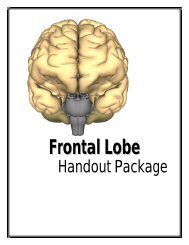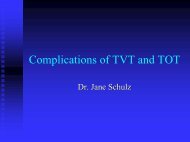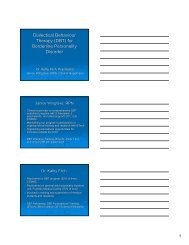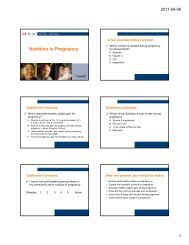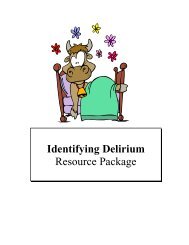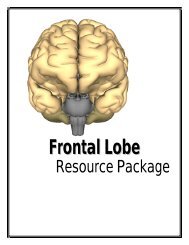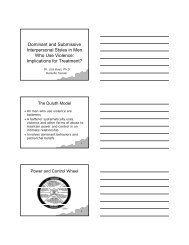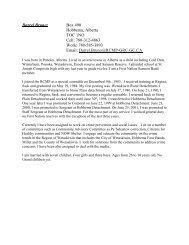Auditory Processing Disorders vs. Language ... - Onehealth.ca
Auditory Processing Disorders vs. Language ... - Onehealth.ca
Auditory Processing Disorders vs. Language ... - Onehealth.ca
Create successful ePaper yourself
Turn your PDF publications into a flip-book with our unique Google optimized e-Paper software.
CENTRAL AUDITORY PROCESSING DISORDERGeneral Definition<strong>Auditory</strong> processing disorder is a congenital as well as an acquiredcondition (for example; resulting from ear infections and headinjuries) which refers to difficulties in the processing of auditoryinformation within the central nervous system, such as problems with:"...sound lo<strong>ca</strong>lization and lateralization; auditory discrimination;auditory pattern recognition; temporal aspects of audition, includingtemporal integration, temporal discrimination (e.g., temporal gapdetection), temporal ordering, and temporal masking; auditoryperformance in competing acoustic signals (including dichotic listening);and auditory performance with degraded acoustic signals." (Quotefrom: (Central) <strong>Auditory</strong> <strong>Processing</strong> <strong>Disorders</strong>, Techni<strong>ca</strong>l Report, Jan2005)This <strong>ca</strong>n manifest as problems determining the direction of sounds,difficulty perceiving differences between speech sounds and thesequencing of these sounds into meaningful words, confusing similarsounds such as "hat" with "bat", "there" with "where" etc. Fewer wordsmay be perceived than were actually said, as there <strong>ca</strong>n be problemsdetecting the gaps between words, creating the sense that someone isspeaking unfamiliar or nonsense words. There may also be problemsrelating what has been said with its meaning, despite obvious recognitionthat a word has been said. Separating speech sounds from backgroundnoise such as the sound of a radio or television <strong>ca</strong>n be difficult. In areassuch as a noisy classroom or gym, it <strong>ca</strong>n be difficult to impossible tounderstand speech, depending on the severity of the (auditoryprocessing) condition. For those with (C)APD, speaking on a telephone <strong>ca</strong>nbe a problem, due to low quality audio, poor signal, intermittent soundsand the chopping of words, in comparison with someone with normalauditory processing (hearing).It should be noted that memory issues are not longer part of thedefinition for this disorder.
Frequently Asked QuestionsIf I am interested in referring a student for an auditory processingassessment what is the process?Each office should have a referral package for (C)APD testing. This hasrecently been updated to streamline the process. Once the family andthe school have completed the forms and obtained a copy of the SLP anda psychologi<strong>ca</strong>l report, send the package to the Audiology Department atRichmond Road (fax – 403- 943-8501). Remember that the studentneeds to be at least 7 years of age. If the reports are older than 3years please contact Charlene Watson at (403)955-8515 to discussoptions.Can a school initiate this service?Sometimes a school or private psychologist will want a student referred.The school <strong>ca</strong>n also follow this same procedure and send the completedpackage directly to the Audiology Department. They will once again needto have all the referral pages filled out and will require a report fromboth the psychologist and the SLP. It should be mentioned that the SLPreport <strong>ca</strong>nnot be copied from the cumulative file. The family will need tocopy their personal report to attach or the Audiology Department willhave to request it internally.What tests do I need to administer as a Speech-<strong>Language</strong>Pathologist?You are the professional and it is up to you to make the decision as towhat evaluation measures you require in order to determine the needs ofthe student. We have suggested some specific tests that <strong>ca</strong>n offer theAudiologist more information. These include a phonologi<strong>ca</strong>l awarenesstest (or even the sub-test from the CELP-4), an auditory discriminationtest and/or the Differential Screening Test for <strong>Auditory</strong> <strong>Processing</strong><strong>Disorders</strong>. It should be mentioned that recently a couple of students
diagnosed with (C)APD were given the Differential Screening Test andhad not passed it.I refer students in for testing but I have not had one come backwith a diagnosis. How often do you find a student with thisdisorder?(C)APD occurs in about 2-3% of children, with a 2:1 ratio between boysand girls (of 90 children assessed at the RRDTC in 2009 2 werediagnosed with APD).Since it is so infrequent should I keep on referring students fortesting?Absolutely, if a child is having difficulty listening/following directions inthe classroom, struggling with reading, misunderstanding what is beingsaid, showing greater difficulty listening when the classroom is noisy, inlight of normal hearing, cognitive function and language processing then(C)APD testing may need to be ruled in or out. Even if (C)APD testing isnormal this provides more information about the child’s listening abilitiesand whether this is a mode teachers <strong>ca</strong>n utilize to help the child learnand function in the classroom setting.What does the audiologist offer to families of students who havebeen identified?(C)APD therapy is dependent on the diagnosis. If the child is strugglingwith temporal resolution skills (timing issues) then a pattern recognitiongame such as Simon 2 is provided to develop these skills. If the child isexperiencing difficulty listening to two things at the same time thendichotic listening therapy is recommended. An example of this would behaving the child listen to a book on tape with background noise present.If the child is exhibiting difficulty with basic discrimination, Earobicsmay be recommended. Once the therapy has been completed (C)APDskills are retested both behaviourally and electrophysiologi<strong>ca</strong>lly todetermine if the skills have improved or if therapy should continue. Justrecently a boy was reviewed and improved his auditory skills afterremediation.
Does the audiologist offer anything to families of students who donot have this disorder?Yes, typi<strong>ca</strong>lly if children are not diagnosed with APD and exhibit reading,writing, or spelling difficulties, we recommend the Earobics program.This program develops basic discrimination, differentiation, and listeningskills which are all important for reading, writing and spelling. We alsooffer listening strategies that are useful at home and in the classroom.Why do you not test students with PDD?These children do not have a normal auditory system. Their auditoryprocessing problems may be due to the autism.Do you test students that are DHOH (Deaf or Hard of Hearing)?No we do not test these students since we know that the sounds thatthey are hearing are not normal. The plasticity of their brains may notbe the same as typi<strong>ca</strong>l hearing students.Will you test students with a Learning Disability?There is a higher percentage of students with a learning disability thathave (C)APD problems. New research suggests 30-50% of children withlearning disabilities may also have auditory processing difficulties.Often we feel pressured to send in a referral for (C)APD testing bythe school and/or psychologist. How should we deal with this?If through your testing you have determined a reason why the child isexperiencing problems in the classroom or at home then you should dealwith that difficulty and determine appropriate strategies. If throughyour testing you are still puzzled why they are having problems, then youshould refer this child for (C)APD testing.
Do you recommend any books on this subject?There is a techni<strong>ca</strong>l two book set that was published in 2007 thatprovides insight in this disorder from several experts in the field. Thetitle of these books is:1. Handbook of (Central) <strong>Auditory</strong> <strong>Processing</strong> Disorder: <strong>Auditory</strong>Neuroscience and Diagnosis Volume I2. Handbook of (Central) <strong>Auditory</strong> <strong>Processing</strong> Disorder: ComprehensiveIntervention Volume IIGail D. ChermakFrank E. MusiekPlural Publishing Inc.You could check recent journals or search the world wide web.Can you give an example of the difference between C(APD) and alanguage processing disorder?If the question is “Tell me how a chair and a couch are alike?” the personwith an auditory processing problem may hear it as “Tell me how a couch,van and chair are alike?” or “Tell me how a hair and a cow are alike?” Theperson with a language processing problem would hear the question “Tellme how a chair and a couch are alike but would not be able to answer thisquestion.Charlene Watson, Sherri Garries, & Barb Hard<strong>ca</strong>stle (AHS)





